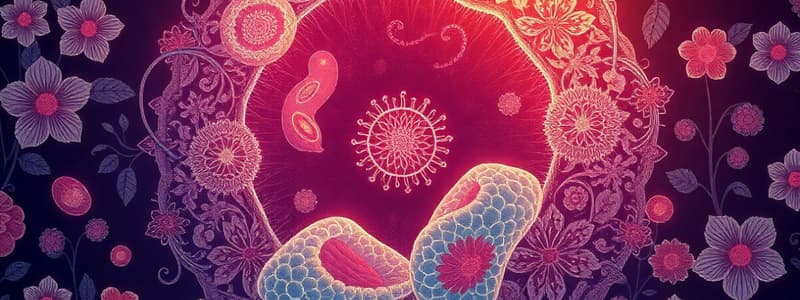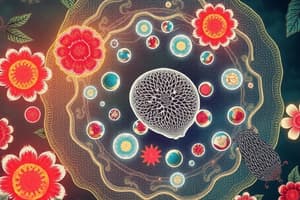Podcast
Questions and Answers
Which type of cell junction is characterized by its direct connection to intermediate filaments?
Which type of cell junction is characterized by its direct connection to intermediate filaments?
- Desmosomes (correct)
- Adherens junctions
- Focal adhesions
- Gap junctions
Which of the following is NOT a function of intermediate filaments?
Which of the following is NOT a function of intermediate filaments?
- Facilitating paracellular permeability (correct)
- Creating cell cohesion and preventing cell sheet fracture under tension
- Establishing cell shape
- Providing structure for internal organelles
Which of the following pairs correctly matches a cell junction with its associated cytoskeletal element?
Which of the following pairs correctly matches a cell junction with its associated cytoskeletal element?
- Adherens junctions and microtubules
- Tight junctions and intermediate filaments
- Focal adhesions and actin filaments (correct)
- Desmosomes and actin filaments
What is the primary function of tight junctions?
What is the primary function of tight junctions?
Which protein family is primarily associated with the formation of desmosomes?
Which protein family is primarily associated with the formation of desmosomes?
Which of the following structures is NOT a component of the endomembrane system?
Which of the following structures is NOT a component of the endomembrane system?
What is the primary function of the nuclear lamina?
What is the primary function of the nuclear lamina?
Which of the following is directly involved in the organization and movement of chromosomes during cell division?
Which of the following is directly involved in the organization and movement of chromosomes during cell division?
Where would you most likely find chromatin?
Where would you most likely find chromatin?
Which of the following membrane-bound organelles is involved in the breakdown and recycling of cellular waste?
Which of the following membrane-bound organelles is involved in the breakdown and recycling of cellular waste?
Which of the following is NOT a component of the extracellular matrix?
Which of the following is NOT a component of the extracellular matrix?
What structural protein is a main component of centrioles?
What structural protein is a main component of centrioles?
How many microtubule triplets are found in a centriole?
How many microtubule triplets are found in a centriole?
Which of the following best describes the function of the centrosome?
Which of the following best describes the function of the centrosome?
What is the arrangement of microtubules in cilia and flagella?
What is the arrangement of microtubules in cilia and flagella?
What type of movement is characteristic of flagella?
What type of movement is characteristic of flagella?
What is a primary difference in quantity between cilia and flagella in a typical cell?
What is a primary difference in quantity between cilia and flagella in a typical cell?
What is a key characteristic of intermediate filaments?
What is a key characteristic of intermediate filaments?
What is the primary function of glyoxysomes within germinating seeds?
What is the primary function of glyoxysomes within germinating seeds?
Which of the following best describes the lipid composition of plastids?
Which of the following best describes the lipid composition of plastids?
Which type of plastid is responsible for storing starch, especially in roots and shoots?
Which type of plastid is responsible for storing starch, especially in roots and shoots?
Where are the proteins and pigments such as chlorophyll and carotenoids primarily located within chloroplasts?
Where are the proteins and pigments such as chlorophyll and carotenoids primarily located within chloroplasts?
Which of the following describes the function of leucoplasts in secretory tissues?
Which of the following describes the function of leucoplasts in secretory tissues?
Which type of cells in land plants are typically motile and possess flagella?
Which type of cells in land plants are typically motile and possess flagella?
Which component of a plant cell wall is primarily responsible for making it less vulnerable to fungal attacks?
Which component of a plant cell wall is primarily responsible for making it less vulnerable to fungal attacks?
What is the typical arrangement of microtubules in a flagellum’s axoneme?
What is the typical arrangement of microtubules in a flagellum’s axoneme?
What is the primary function of the middle lamella in plant cells?
What is the primary function of the middle lamella in plant cells?
What structure directly facilitates the transport of cytoplasmic molecules between neighboring plant cells?
What structure directly facilitates the transport of cytoplasmic molecules between neighboring plant cells?
Which of the following is a primary component of the extracellular matrix in animal cells?
Which of the following is a primary component of the extracellular matrix in animal cells?
What is the phragmoplast and when is it formed in plant cells?
What is the phragmoplast and when is it formed in plant cells?
Which of the following does NOT directly participate in the formation of the microtubule organizing center (MTOC) in plants?
Which of the following does NOT directly participate in the formation of the microtubule organizing center (MTOC) in plants?
What role does the endomembrane system play in plant cells?
What role does the endomembrane system play in plant cells?
Which structure within plant cells is responsible for maintaining cell tonicity?
Which structure within plant cells is responsible for maintaining cell tonicity?
What is the function of lytic vacuoles in plant cells?
What is the function of lytic vacuoles in plant cells?
Which unique structural feature is characteristic of oil bodies in plant cells?
Which unique structural feature is characteristic of oil bodies in plant cells?
What is the primary function of peroxisomes in plant leaf cells?
What is the primary function of peroxisomes in plant leaf cells?
What is the primary function of pectins within the plant cell wall?
What is the primary function of pectins within the plant cell wall?
Which of the following is primarily responsible for the synthesis of cellulose in plant cells?
Which of the following is primarily responsible for the synthesis of cellulose in plant cells?
What structural component is unique to secondary cell walls that imparts significant strength?
What structural component is unique to secondary cell walls that imparts significant strength?
What chemical property of cellulose microfibrils contributes to their high tensile strength?
What chemical property of cellulose microfibrils contributes to their high tensile strength?
How do H+ ions contribute to primary cell wall expansion?
How do H+ ions contribute to primary cell wall expansion?
Which molecule plays a key role in linking microfibrils into a network within the plant cell wall?
Which molecule plays a key role in linking microfibrils into a network within the plant cell wall?
What distinguishes a primary cell wall from a secondary cell wall?
What distinguishes a primary cell wall from a secondary cell wall?
How does turgor pressure contribute to the expansion of the primary cell wall?
How does turgor pressure contribute to the expansion of the primary cell wall?
Which of the four groups of plant cell wall polysaccharides is not synthesized in the RER and Golgi?
Which of the four groups of plant cell wall polysaccharides is not synthesized in the RER and Golgi?
Which of the following describes the structure of a macrofibril in a plant cell wall?
Which of the following describes the structure of a macrofibril in a plant cell wall?
Flashcards
Plasma Membrane
Plasma Membrane
A selectively permeable barrier that encloses the cell, regulating the passage of molecules in and out.
Cytoplasm
Cytoplasm
The gel-like substance within the cell, containing all the organelles and cytosol.
Nucleus
Nucleus
The control center of the cell, containing genetic material (DNA) and directing cellular activities.
Endoplasmic Reticulum (ER)
Endoplasmic Reticulum (ER)
Signup and view all the flashcards
Golgi Apparatus
Golgi Apparatus
Signup and view all the flashcards
Cell Wall
Cell Wall
Signup and view all the flashcards
Primary Cell Wall
Primary Cell Wall
Signup and view all the flashcards
Secondary Cell Wall
Secondary Cell Wall
Signup and view all the flashcards
Cellulose
Cellulose
Signup and view all the flashcards
Hemicellulose
Hemicellulose
Signup and view all the flashcards
Pectin
Pectin
Signup and view all the flashcards
Glycans
Glycans
Signup and view all the flashcards
Lignin
Lignin
Signup and view all the flashcards
Cell Wall Expansion
Cell Wall Expansion
Signup and view all the flashcards
Turgor Pressure
Turgor Pressure
Signup and view all the flashcards
Cell Plate
Cell Plate
Signup and view all the flashcards
Microtubule Organizing Center (MTOC)
Microtubule Organizing Center (MTOC)
Signup and view all the flashcards
Endomembrane System
Endomembrane System
Signup and view all the flashcards
Vacuoles
Vacuoles
Signup and view all the flashcards
Central Vacuole
Central Vacuole
Signup and view all the flashcards
Lytic Vacuoles
Lytic Vacuoles
Signup and view all the flashcards
Peroxisomes
Peroxisomes
Signup and view all the flashcards
Middle Lamella
Middle Lamella
Signup and view all the flashcards
Plasmodesmata
Plasmodesmata
Signup and view all the flashcards
Intermediate Filaments
Intermediate Filaments
Signup and view all the flashcards
Nuclear Lamina
Nuclear Lamina
Signup and view all the flashcards
Tight Junctions
Tight Junctions
Signup and view all the flashcards
Desmosomes
Desmosomes
Signup and view all the flashcards
Focal Adhesions
Focal Adhesions
Signup and view all the flashcards
Glyoxysome
Glyoxysome
Signup and view all the flashcards
Semiautonomous Organelles
Semiautonomous Organelles
Signup and view all the flashcards
Chloroplasts
Chloroplasts
Signup and view all the flashcards
Amyloplasts
Amyloplasts
Signup and view all the flashcards
Chloroplasts Structure
Chloroplasts Structure
Signup and view all the flashcards
Flagella Structure
Flagella Structure
Signup and view all the flashcards
Flagellated Sperm
Flagellated Sperm
Signup and view all the flashcards
Extracellular Matrix
Extracellular Matrix
Signup and view all the flashcards
Extracellular Matrix (ECM)
Extracellular Matrix (ECM)
Signup and view all the flashcards
Elastin
Elastin
Signup and view all the flashcards
Fibronectin
Fibronectin
Signup and view all the flashcards
Laminin
Laminin
Signup and view all the flashcards
Centrioles
Centrioles
Signup and view all the flashcards
Centrosome
Centrosome
Signup and view all the flashcards
Cilia and Flagella
Cilia and Flagella
Signup and view all the flashcards
Study Notes
Plant Cell Organelles
- Plant cells have unique organelles not found in animal cells.
- Chloroplasts are sites of photosynthesis, converting light energy into chemical energy.
- Central vacuoles maintain turgor pressure, a key factor in plant growth.
- Cell walls, composed of cellulose, provide support and rigidity, a feature not seen in animals.
- Plasmodesmata are channels connecting adjacent plant cells, enabling communication and transport.
- Vacuoles, in addition to other functions, can contain pigment or storage material.
Animal Cell Organelles
- Animal cells possess organelles not found in plant cells.
- Centrioles are involved in cell division, forming the spindle apparatus.
- Lysosomes are specialized organelles for intracellular digestion and waste removal.
Similar Organelles in Plant and Animal Cells
- Plasma membrane: Encloses the cell, regulating what enters and leaves.
- Cytoplasm: Jelly-like substance filling the cell.
- Nucleus: Contains the genetic material (DNA) and controls cellular activities.
- Ribosomes: Synthesize proteins (essential for both).
- Endoplasmic reticulum (ER): A network of membranes involved in protein synthesis and transport.
- Golgi apparatus: Processes and packages proteins for secretion.
- Mitochondria: Produce energy through cellular respiration.
The Endomembrane System
- A system of interconnected membranes in the cell.
- Includes nuclear envelope, ER, Golgi apparatus, vesicles, and lysosomes/ vacuoles.
- Major functions include protein synthesis, transport, and modification.
Vacuoles
- Membrane-bound sacs involved in storage and transport.
- Central vacuoles in plant cells are large, playing a vital role in turgor pressure and maintaining cell shape.
- Lytic vacuoles in plant cells and lysosomes in animal cells are involved in digestion.
Cell Wall
- Found only in plant cells, outside the plasma membrane.
- Composed of cellulose, hemicellulose, pectins and glycans.
- Provides structural support and protection.
- Consists of three layers: primary cell wall, secondary cell wall, and middle lamella.
- Middle lamella glues adjacent cells together.
Plastids
- Plant-specific organelles with various roles.
- Chloroplasts: Sites of photosynthesis, contain chlorophyll.
- Leucoplasts: Non-pigmented, often store starch or lipids.
- Amyloplasts: A type of leucoplast specialized for starch storage.
Peroxisomes and Glyoxysomes
- Membrane-bound organelles involved in specialized metabolic processes.
- Peroxisomes oxidize organic molecules to H2O2, in leaves, involved in photorespiration.
- Glyoxysomes in germinating seeds are responsible for converting fatty acids to sugars for energy.
Cytokinesis
- The process of cell division, specifically the division of the cytoplasm.
- In plants, a cell plate forms to divide the cytoplasm.
- Microtubules and actin form a phragmoplast during cell wall formation.
Microtubule Organizing Center (MTOC)
- Microtubules originate from this center.
- Composed of y-tubulin.
- Not found in plant cells (centrioles are)
Cell Junctions
- Structures that connect adjacent animal cells.
- Types include tight junctions, adherens junctions, desmosomes, gap junctions, and focal adhesions, hemidesmosomes.
- These junctions allow communication and support.
Nuclear Lamina
- A network of intermediate filaments (lamins) that provides structural support to the nuclear envelope.
- Important for maintaining nuclear shape and function.
- Animal cells have lamins. Plant cells have different molecules instead
Cilia and Flagella
- Motile appendages of eukaryotic cells, involved in movement.
- Their structure (9+2 arrangement of microtubules) is characteristic of eukaryotic cells.
- Cilia are numerous and shorter, flagella are fewer and longer.
Differences Between Cilia and Flagella
- Cilia typically occur in large numbers; flagella in fewer quantities.
- Cilia are usually shorter than flagella.
- Cilia generally move in a coordinated fashion; flagella usually move in a whiplike motion.
Studying That Suits You
Use AI to generate personalized quizzes and flashcards to suit your learning preferences.





